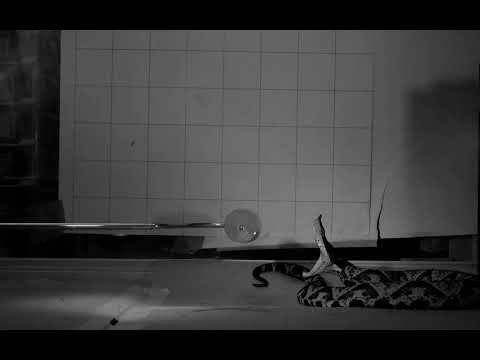A venomous snake bite is not something you ever want to encounter on a hiking or camping trip. For those brave scientists who study snakes–aka herpetologists–the mechanics behind the reptiles’ fast fangs are more fascinating than fear-inducing. Snakes must move incredibly quickly to sink their fangs into prey before the victim flinches. When hunting rodents, this may be as little as 60 milliseconds.
With advances in video technology, a group from Monash University in Australia are getting an up-close-and-personal look at how venomous viper, elapid, and colubrid snakes flex their fangs. In their study published today in the Journal of Experimental Biology, the team describes the differences between bite tactics in these different types of snakes.
Finding snakes in…France?
Despite working in one of the world’s snake hotspots, study co-authors Alistair Evans and Silke Cleuren traveled from Australia to Venomworld outside of Paris. At Venomworld, herpetologist Remi Ksas collects venom from some of the world’s most dangerous snakes for medical and pharmaceutical uses.
Cleuren, Ksas, and Anthony Herrel of France’s Museum national d’Histoire naturelle studied 36 species of snake, including western diamondback rattlesnakes (Crotalus atrox), west African carpet vipers (Echis ocellatus), and the rough-scaled death adder (Acanthophis rugosus). They tempted the snakes to lunge at a cylinder of warm muscle-like medical gel resembling a small animal.
[ Related: The sharp science behind fangs, the ultimate biting weapon. ]
They used two cameras running at 1,000 frames per second to record the encounters, in order to recreate the snakes’ lightning-fast maneuvers in 3D. Cleuren recalls that she “flinched a couple of times,” but that the adrenaline rush was worthwhile to get this footage. They ended up capturing more than 100 snake strikes in minute detail.
They found that venomous snakes use dramatically different strategies to deliver their deadly bites. Vipers and elapids strike more elegantly before their victims are even aware of their presence, while colubrid bites inflict the maximum amount of damage.
Vipers: The speed demons

A viper (Deinagkistrodon acutus) striking a cylinder of medical gel. The movie is played at 3 percent speed. CREDIT: Silke Cleuren
When a viper strikes, they sink their fangs into their victims’ skin before moving it into a position where they can inject their deadly venom. They embed their fangs into their prey within 100 milliseconds of launching a strike.
The blunt-nosed viper (Macrovipera lebetina) can accelerate up to 710 meters per second squared, or about 1,588 miles per hour in one second. It will also land its bite within 22 milliseconds.
The vipers in the study also moved the fastest as they struck. Bothrops asper–or the ultimate pit-viper–reaches speeds of over 4.5 meters per second after hitting accelerations of more than 370 meters per second squared.
When focusing on the vipers’ fangs, the team watched their needle-like teeth sink into the fake prey. However, if the viper was not satisfied with the position of a fang, it pulled it out to reinsert it at a better angle. The vipers closed their jaws to inject the venom only when their fangs were comfortably in place.
Elapids: The masters of stealth

An elapid snake (Aspidelaps lubricus) striking a cylinder of medical gel. The movie is played at 3 percent speed. CREDIT: Silke Cleuren
The elapid snakes in their studies bit their victims as quickly as the vipers. However, the fastest elapid–the rough-scaled death adder–only clocked speeds of 2.5 meters per second.
They deployed a different strategy of squeezing the venom into their victims by biting repeatedly. The Cape coral cobra (Aspidelaps lubricus) and the forest cobra (Naja melanoleuca), act in a more stealthy fashion. They creep closer to their victim before lunging and biting repeatedly. While biting, their jaw muscles tensed to squeeze venom into their meal.
Colubrids: Biting with ‘saw’ jaws

A colubrid snake (Toxicodryas pulverulenta) striking a cylinder of medical gel. The movie is played at 30 percent speed. CREDIT: Silke Cleuren.
A colubrid snake (Toxicodryas pulverulenta) striking a cylinder of medical gel. The movie is played at 30 percent speed. CREDIT: Silke Cleuren.
The two colubrid snakes in the study had fangs further back in their mouths. They lunged over the greatest distances before clamping their jaws around a meal. Once in place, they swept their jaws from side-to-side to tear a crescent-shaped gash in the victim. With the gash in place, they delivered the maximum dose of venom.
Snakes, they’re just like us
On one occasion, a blunt-nosed viper misjudged the distance to its prey. The result? Its right fang broke off.
According to the team, this kind of fang breakage likely occurs fairly often. Fangs tend to turn up in snake poop after they are swallowed.



